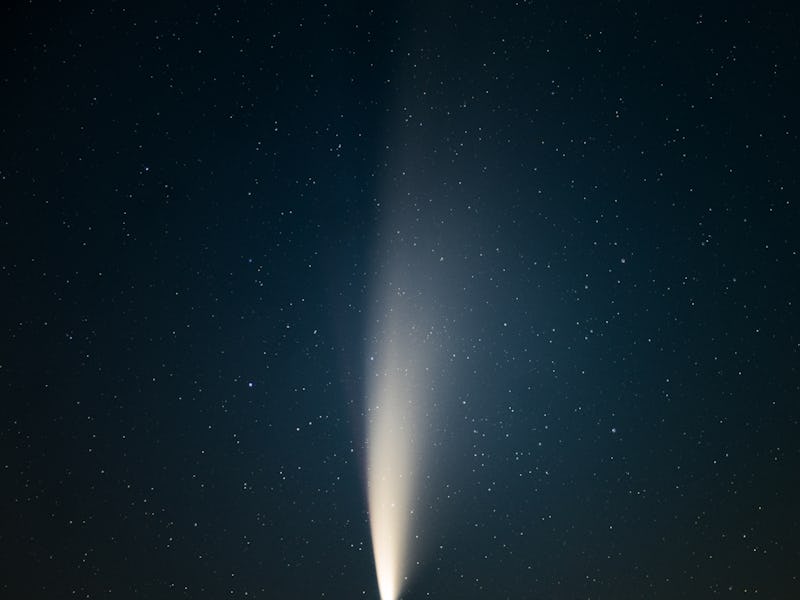Astronomers discover new dwarf planet or strange comet on eccentric orbit around the Sun
The celestial body could come close enough to the Sun for us to launch a mission.

Celestial objects like comets are often discovered on their way out of the main part of the Solar System and back to its outer reaches.
But a new discovery has astronomers excited: we’ve found a massive new object as it's on its way from the far, far outer solar system. Within the next decade, it could come to just a hair short of Saturn’s orbit before returning to the edge of our Solar System.
“This is great — we've got a decade to watch it come in closer and learn about it,” Samantha Lawler, an astronomy professor at the University of Regina, tells Inverse. “So it's really a fantastic discovery.”
The discovery was announced on Saturday, and astronomers are currently performing follow-up observations on the new object, 2014 UN271, to figure out a few things. For instance, its distance — both now and in the near future.
- Distances in the solar system are often measured in astronomical units (AU), or the distance between the center of the Earth and the center of the Sun, approximately 93 million miles.
- Right now, 2014 UN271 is about 22 AUs from the Sun. For reference, Neptune is about 29.7 AU away from the Sun.
- Based on preliminary observations, it is expected to come as close as 10.9 AUs from the Sun by the year 2031. (Saturn is between 9 and 10.1 AU from the Sun, depending on its orbit.)
- The object has traveled 7 AUs in the last seven years.
- It could come from as far out as 14,000 AU. (Some estimate place it out even further.)
- With such an eccentric orbit, it takes about 600,000 years to circle our star.
Then there’s the matter of size. It could be anywhere between 62 and 230 miles wide. If it’s more toward the former, it’s a massive comet. If it’s far to the latter, it might have been able to round out and differentiate inside to become a dwarf planet.
A diagram that illustrates the new object’s eccentric orbit around the Sun.
How was 2014 UN271 discovered?
The newly discovered object was dubbed 2014 UN271, and was recently identified in data gathered by the Dark Energy Survey (DES) from the years 2014-2018.
DES is an international effort to probe the nature of the mysterious dark matter responsible for the expansion of the universe. It does so by surveying large regions of the sky to map out millions of galaxies.
Marshall Eubanks, an astronomer and co-founder of Space Initiatives, explains that the same technology can be used for detecting Solar System objects.
“Instead of a spot being here and then here, the spot is changing [position],” Eubanks tells Inverse. “And so they did a deep data dive on it, looking for possibly moving objects.”
Is 2014 UN217 a planet or a comet?
In the data, 2014 UN217 appeared as a fuzzy shape, with only a rough estimate of its size, which is why making the determination between a large comet and a small dwarf planet is difficult. But that may soon change.
“A lot of astronomers are going to put a lot of telescopes looking at this thing,” Eubanks says. “They will find out all kinds of things in fairly short order.”
If it were a comet, it would be one of the largest comets ever discovered. The two largest comets to visit past the orbit of Saturn were both around 60 miles across, while most were much, much smaller.
“We find a lot of comets on very similar orbits, but they're usually a lot smaller,” Lawler says. “This one may be the biggest object on this type of orbit that we've ever found.”
For it to be a comet, astronomers are waiting to see if it displays the familiar tail of a comet, which is produced as icy material from the comet’s surface is vaporized from the Sun’s radiation.
On the other hand, it could be a dwarf planet from the Oort Cloud.
The Oort Cloud is a theoretical cloud of small icy objects that surround the Sun at a distance that reaches up to 3.2 light years away. If the object is, indeed, from 14,000 AU away, that would place its farthest distance from the Sun at 0.22 light years.
Can we visit 2014 UN217?
After its discovery was announced, astronomers began suggesting sending a probe to the object to determine its mysterious nature. Exploring 2014 UN217 could inform us of an untold part of the story of the Solar System.
With a sufficiently fast rocket and a quick enough turnaround time, it’s possible to get a flyby mission to the object. Additionally, deep space missions like New Horizons or the European Space Agency’s upcoming Jovian moon probe JUICE could use their instruments to study it from a distance.
“These really wide Oort cloud orbits, we don't know exactly where they came from in the Solar System,” Lawler says. “Did they form closer to the Sun and get scattered up by Jupiter, or did they form closer to Neptune and get scattered by Neptune?”
“It's telling us a lot of the story of our Solar System’s history, which is really neat.”
This article was originally published on